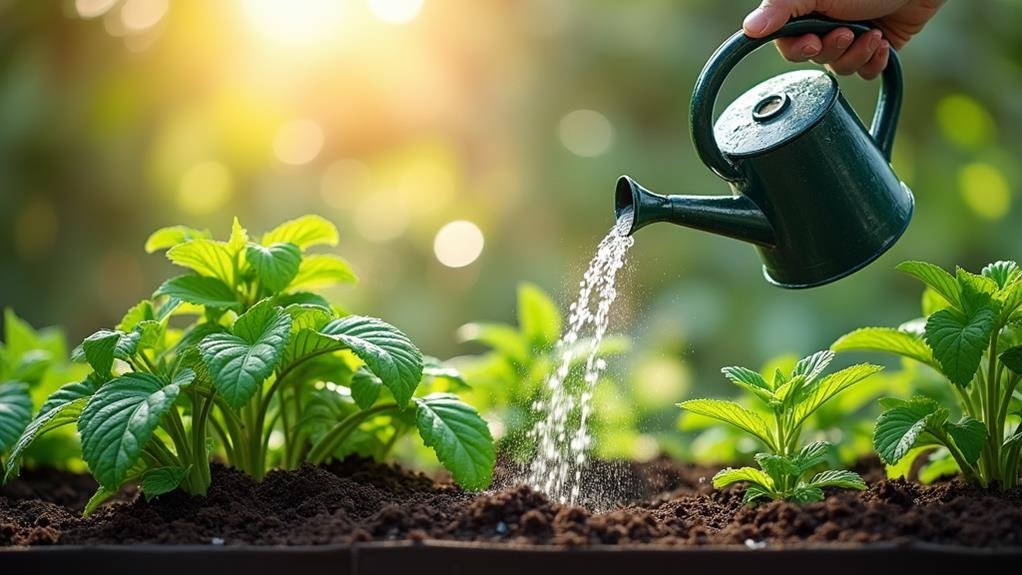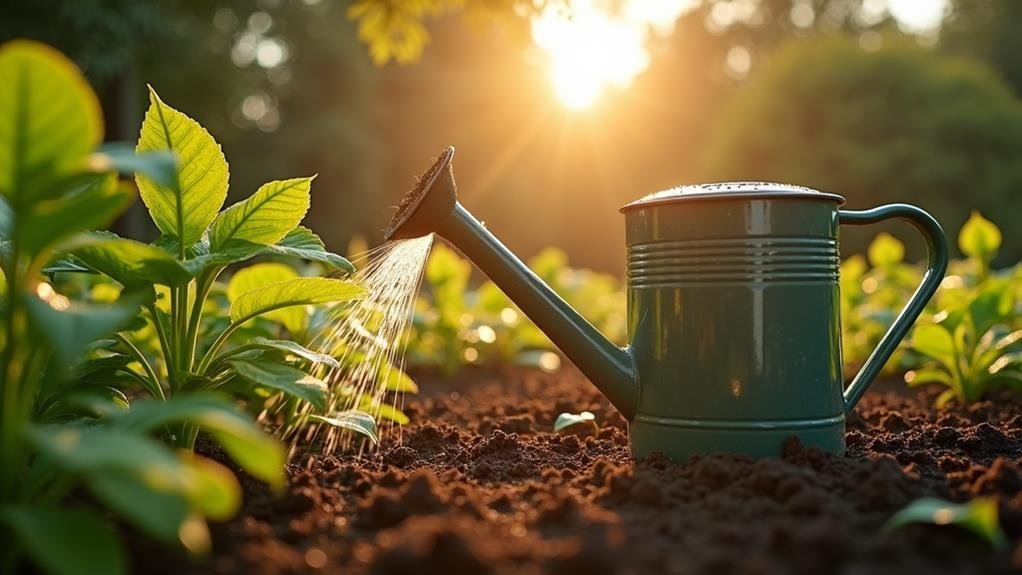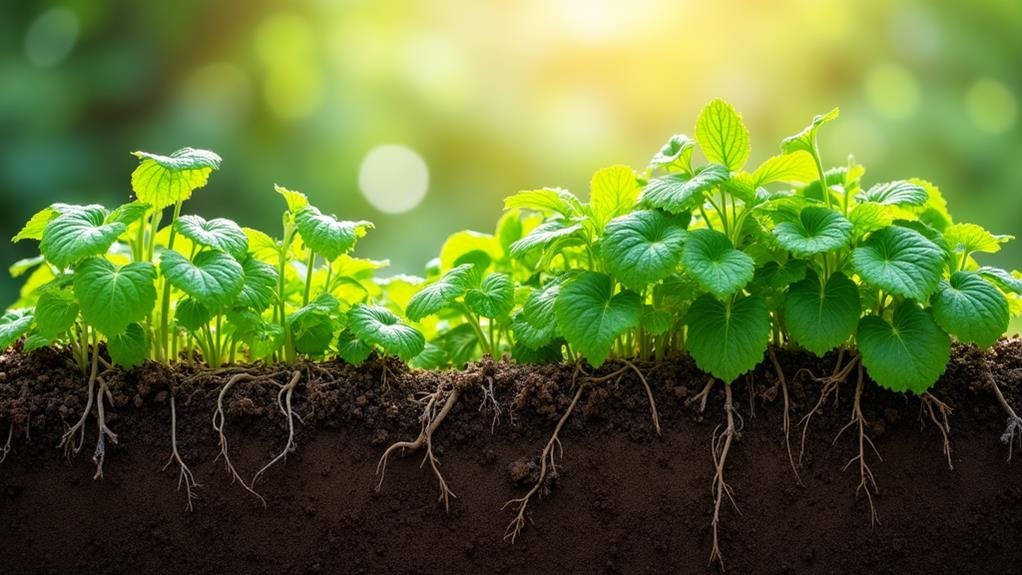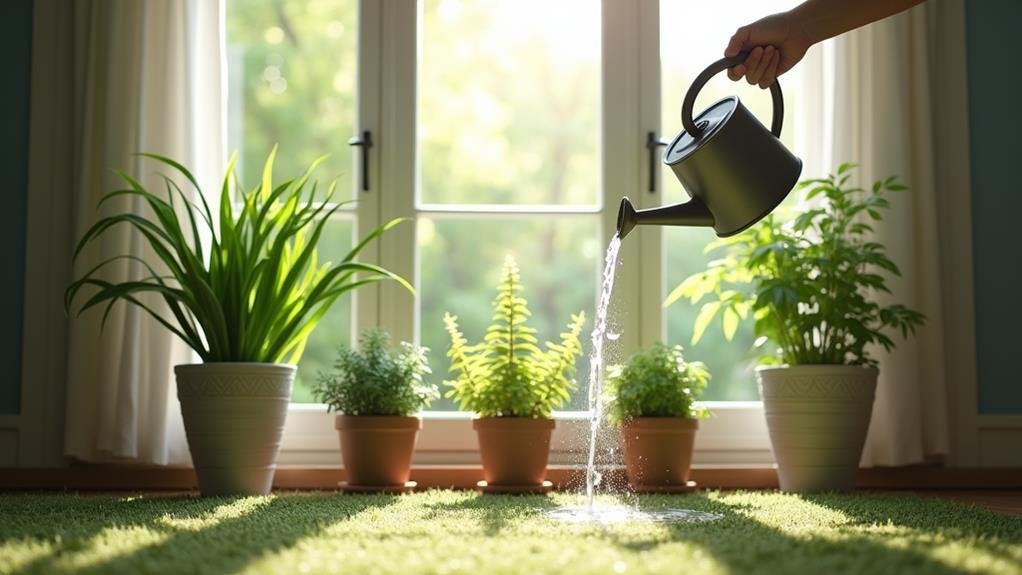When you think about maintaining a healthy garden, proper watering should be at the top of your list. You might not realize it, but how you water can greatly affect your plants' growth and resilience. Each plant has its own moisture requirements, and getting this balance right can be the difference between thriving foliage and struggling stems. But what factors should you consider to guarantee your watering practices are effective? Understanding these nuances can transform your gardening experience, leading to more vibrant plants that stand the test of time. One of the key factors to consider when watering your garden is the depth of the water penetration. Shallow watering can lead to shallow root systems, making plants more susceptible to stress during times of drought. It’s important to focus on deep watering tips for vegetables, ensuring that the water reaches down to where the roots are actively growing. By incorporating these deep watering techniques into your gardening routine, you can help promote healthier, more resilient plants in your vegetable garden.
Understanding Watering Needs

When you first start a garden, understanding the watering needs of your plants is essential for their health and growth. Each plant has different requirements, and knowing these can save you from a dry, wilted disaster or an overwatered swamp. You should consider factors like the type of plant, its stage of growth, and the local climate.
For instance, young seedlings often need more consistent moisture compared to established plants that can tolerate drier conditions. Some plants, like succulents, thrive on neglect, while others, like ferns, prefer a more humid environment.
You'll also want to keep an eye on the weather; hot, sunny days will dry the soil faster, so adjust your watering schedule accordingly.
A good rule of thumb is to check the soil moisture before watering. Stick your finger about an inch deep into the soil; if it feels dry, it's time to water.
Remember, it's better to water deeply and less frequently than to give shallow, frequent drinks. By paying attention to these details, you'll set your garden up for success and enjoy a thriving landscape.
Happy gardening!
Choosing the Right Watering Method
How can you guarantee your plants get just the right amount of water? Choosing the right watering method is essential for achieving this balance. You've got several options, and each has its benefits.
If you want to direct water precisely where it's needed, consider using a watering can or a hose with a spray nozzle. This method allows you to control the flow and target specific plants, minimizing waste.
On the other hand, if you've got a larger garden, a drip irrigation system might be the way to go. This method delivers water directly to the roots, promoting efficient absorption and reducing evaporation.
Plus, it can save you time and effort in the long run.
For those who prefer a more hands-off approach, soaker hoses can also be effective. They slowly release water along their length, providing consistent moisture to the soil.
Timing Your Watering Sessions

Finding the right timing for your watering sessions can make a significant difference in your garden's health. You'll want to water either early in the morning or late in the afternoon. During these times, temperatures are cooler, which helps reduce evaporation. If you water during the heat of the day, much of that water may simply vanish into thin air—talk about a waste!
In the morning, plants have the entire day to absorb moisture before the sun intensifies. This helps them stay hydrated and resilient against midday heat.
On the flip side, watering in the late afternoon allows your plants to soak up water before nightfall, reducing the risk of fungal diseases that can occur with damp foliage overnight.
Be mindful of your local climate, too. If you live in a particularly hot area, you might find that watering in the evening works better.
Just remember, consistency is key. Establish a routine that suits your garden's needs and stick to it.
With the right timing, you'll guarantee your plants receive the hydration they need to thrive, making your garden the envy of the neighborhood!
Monitoring Soil Moisture Levels
Although watering at the right time is essential, understanding your soil's moisture levels is just as significant for your garden's health. Soil moisture impacts your plants' growth, nutrient uptake, and overall health. You can't rely solely on the calendar; instead, pay attention to your garden's unique moisture needs.
To monitor soil moisture, you can use simple methods. One effective approach is the finger test: stick your finger about an inch into the soil. If it feels dry, it's time to water; if it's still damp, hold off.
Another option is to invest in a moisture meter, which provides a quick, accurate reading. These tools can help you avoid overwatering or underwatering, both of which can harm your plants.
Keep in mind that different plants have varying moisture requirements. Some thrive in consistently moist soil, while others prefer drier conditions.
By regularly checking moisture levels, you'll learn your garden's specific needs, allowing you to adjust your watering habits accordingly. With careful monitoring, you'll create a thriving environment where your plants can flourish and grow strong.
Happy gardening!
Adapting Watering for Seasonal Changes

Adapting your watering routine for seasonal changes is essential for maintaining healthy garden plants. As the seasons shift, so do the water needs of your plants.
In spring, you'll likely see increased growth, which means more frequent watering. The soil tends to dry out faster as temperatures rise, so check it regularly and adjust your schedule accordingly.
During the hot summer months, your plants may require daily watering, especially if they're in containers. Early morning is the best time to water, as it allows moisture to soak in before the sun's heat kicks in.
Don't forget to mulch! It helps retain soil moisture and keeps roots cool.
As fall approaches, growth slows down, so you can reduce your watering frequency. Your plants will still need some hydration, particularly if there's a dry spell.
Winter introduces its own set of challenges; many plants enter dormancy and need less water. However, evergreens still require some moisture, so keep an eye on the soil.
Conclusion
To summarize, understanding your plants' watering needs is key to their health and beauty. By choosing the right watering method, timing your sessions effectively, and monitoring soil moisture, you can guarantee your garden thrives. Adapting your approach to seasonal changes further improves your plants' resilience. Remember, a well-watered garden isn't just about quenching thirst; it's about nurturing life. So grab that watering can and keep your plants happy and healthy all season long!




